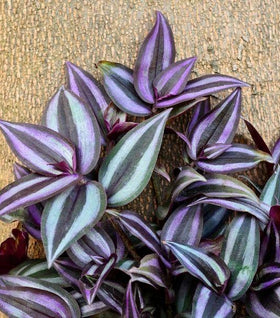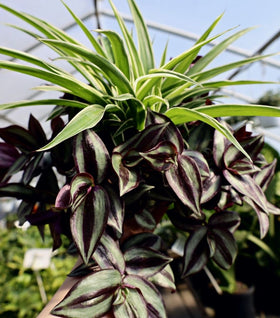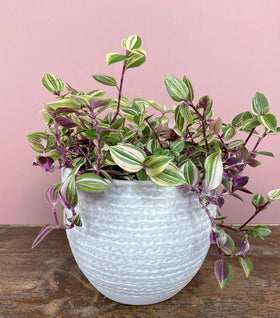Wandering Jew Plants for Sale Online
Long before raising plants for profit became a business, gardeners used to share cuttings from their plants with neighbors and friends, and the plants would travel from place to place. This indoor vining plant hangs beautifully when placed placed in a hanging basket or on the corner of a shelf to allow its vines to grow and cascade.
Their green, heart-shapped leaves have purple and silver striped detailing. Depending on the variety, their leaves can be solid or variegated. Wandering Jew plants are fast growing and easy-to-care for options for any household or indoor space.
Types of Wandering Jew Plants
Spider Plant Wandering Jew Pot Combo
We took two of our best-selling hanging plants and combined them into one easy-to-care-for combination! Spider Plants and wandering jew Plants were made to be a pair. They send out long shoots with occasional flowers on the ends. The green and white foliage of the spider plant complements the colorful foliage of the wandering jew plant.
Tradescantia Nanouk Pink Wandering Jew
This flowering house plant is native to Mexico, South and Central America, and the Caribbean. Tradescantia Nanouk is known for its vibrantly variegated pinkish-purple and lime green foliage. This tropical plant prefers breaks between watering and grows best in bright, indirect light.
Variegated White Wandering Jew
This wandering jew plant is known for being tolerant of a wide range of conditions. Its beautiful white and green foliage cascades down any pot it is planted in. Commonly referred to as small-leaf Spiderwort, this plant makes for the perfect hanging basket or lofted pot.
Wandering Jew Plant
This houseplant is the most commonly seen of the wandering jew plants. You knew it for its deep purple, green, and light pink striped foliage. When grown outdoors, many consider this plant to be fairly invasive, that is why it does best as an indoor vining plant.
Caring for a Wandering Jew Plant
Water
Water your house plant regularly and do not let its soil dry out completely. Always remember to keep the soil evenly moist at all times. However, don't let it ever get soaking wet, this could cause root damage. They can tolerate being overwatered every so often as long as they are placed in a pot that has good drainage holes.
You can also water this plant from the bottom by filling the plant tray with water and allowing the plant to soak it up through the drainage holes of the pot. This way they will soak up plenty of water directly into the soil.
Soil
It is best to use well-aerated soil that is well-draining. This will allow your wandering jew plant to soak up enough water without soaking up too much to drown the plant's roots. If your soil seems too heavy and clay-like, try adding some peat moss and perlite. We recommend using our Ocean Forest potting soil at Garden Goods Direct.
Fertilizer
Wandering Jew plants don't need to be fertilized, but a feed every once in a while is beneficial to the plant. They only need to be fertilized through the spring and summer, avoid fertilizing them in the fall and winter. Any winter growth on these house plants is typically weak and encouraging new growth won't promote strong healthy growth.
Fertilize once a month using an organic plant fertilizer, rather than a chemical one. Feeding your plant will encourage flowering because the blossoms are so small and insignificant the fertilizer helps them pop.
Light
Wandering Jew plants are picky about getting the right amount of light. They need lots of light to help retain their bright-colored foliage, but too much direct sunlight will burn their leaves. Also, if they don't get enough light their leaf colors will fade and look very dull.
The best location for your plant is in an east or west-facing window. This will allow your house plant to get plenty of natural light in the morning and evening, and bright indirect light for the rest of the day.
Pruning
Wandering Jew plants will tolerate heavy pruning, and we recommend making pruning part of your regular care schedule for your vining house plant. The best way to prune this plant is to pinch (trim) the new growth as well as any thin or weak growth and dead leaves. You can also prune off any long tendrils if you prefer to keep your plant compact and thick.
Propagating Wandering Jew Plants
Propagating these house plants is a very easy task to achieve. When you are pruning your plant, hold on to any stem cuttings, they work best when propagating. The first step is to remove all but a few leaves off your stem cuttings and then place them in a smaller pot that contains moist soil and is placed in a warm, bright area. You will start to see new growth after a short 1 to 1.5 months.
Are Wandering Jew Plants Toxic?
These plants, especially their sap, are considered poisonous to animals and humans. If you choose to bring one home make sure you keep it out of reach from any pets or small children. To read more about non-toxic, pet-safe plants, check out our Pet-Safe Plants page on Garden Goods Direct!
Wandering Jew plants are not the most toxic and rarely cause any fatalities, but they are a level #1 toxicity. The sap is the cause of any reactions that can include, skin irritation or a rash on both animals and humans. If ingested by an animal the toxins can bother your pet's digestive tract. There has been no reaction to consuming their leaves, but there is no reason to risk it and allow your pets to be near this plant.
If you’re looking to purchase a Wandering Jew Plant plant for your home or office interior, consider Woodie’s Approved collection of easy-to-grow house plants from Garden Goods Direct. As America’s number one online garden center, we offer a broad selection of houseplants, along with advice from our plant experts you need to keep them healthy. From Aglaonema to ZZ Plants, we have a vast range of house plants, all available from our online store. Buy your house plants online from Garden Goods Direct today!



